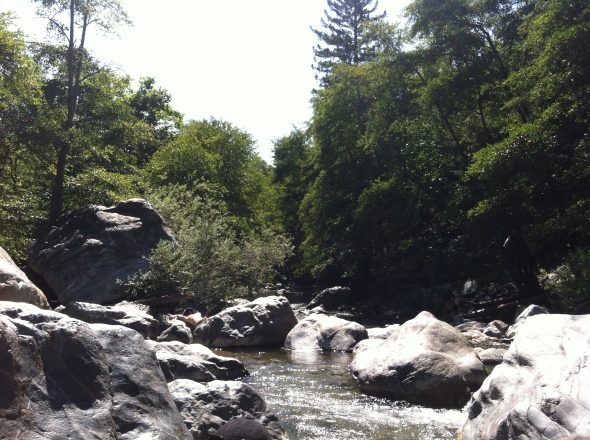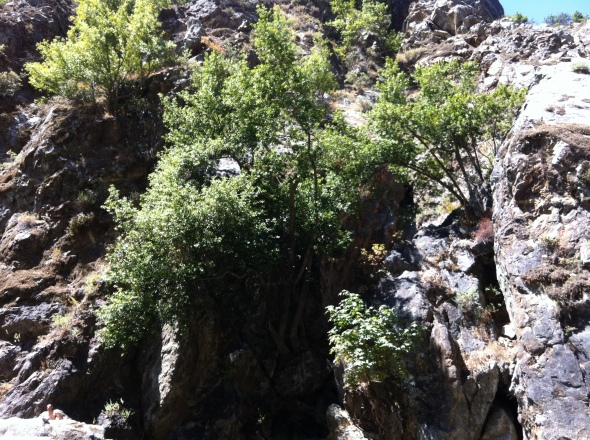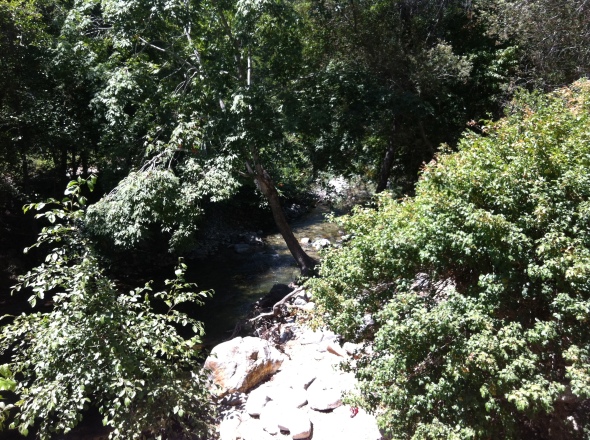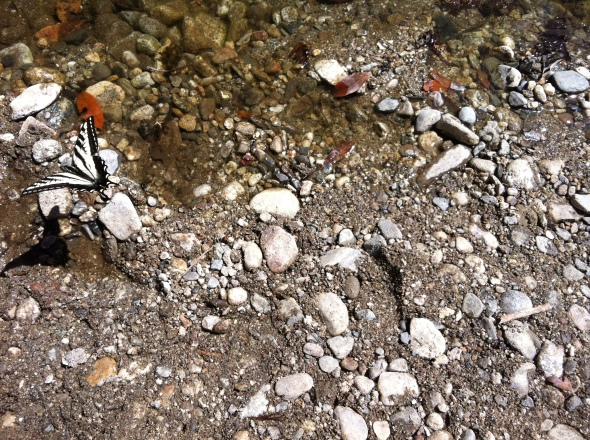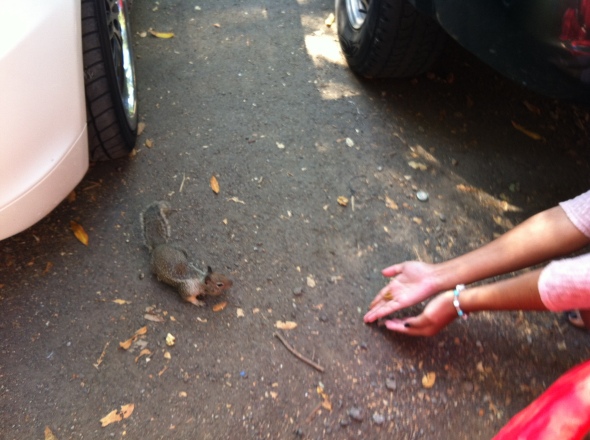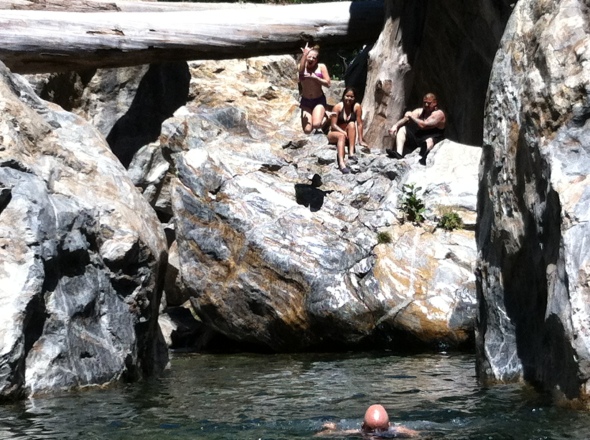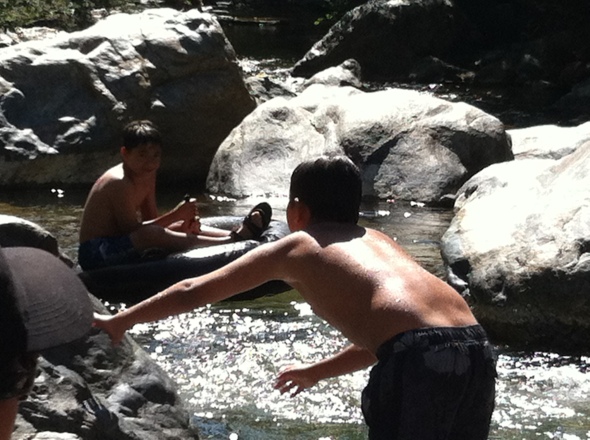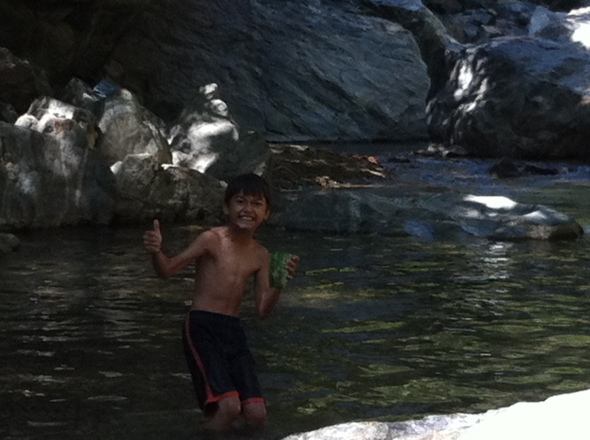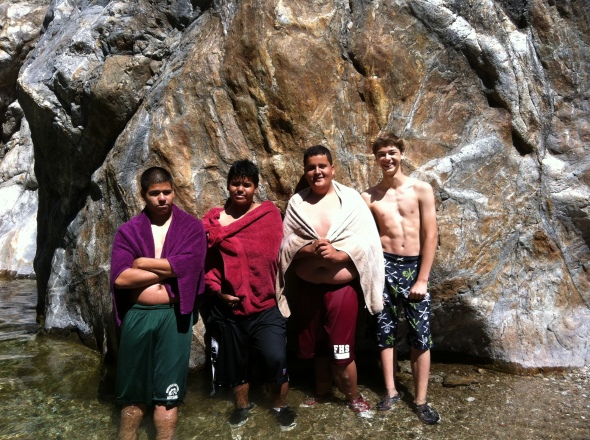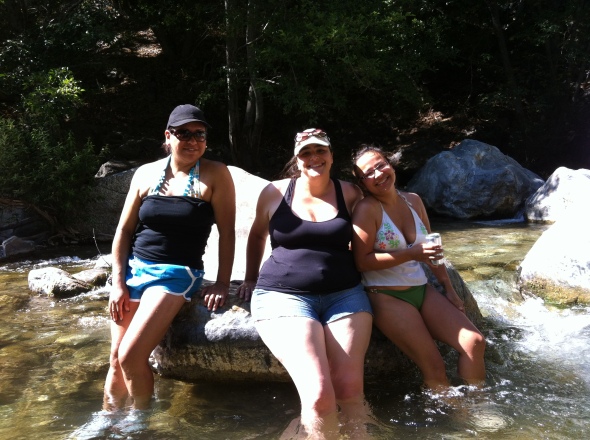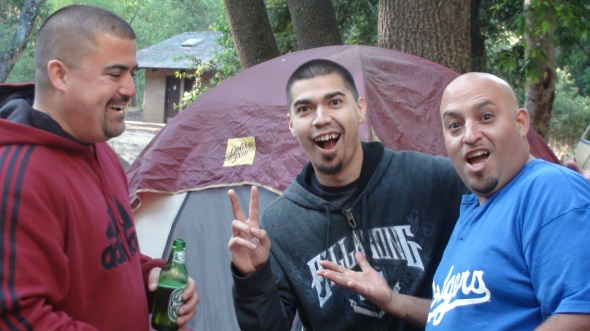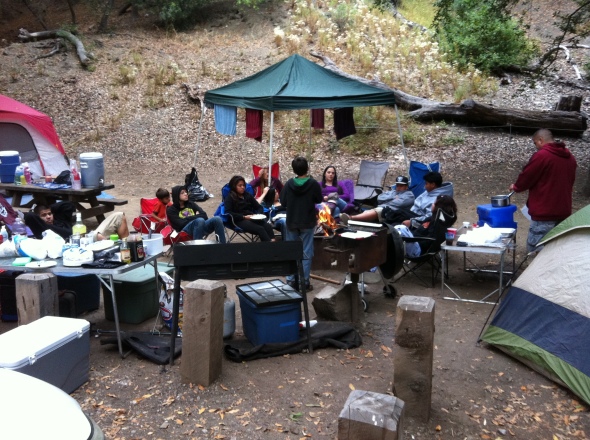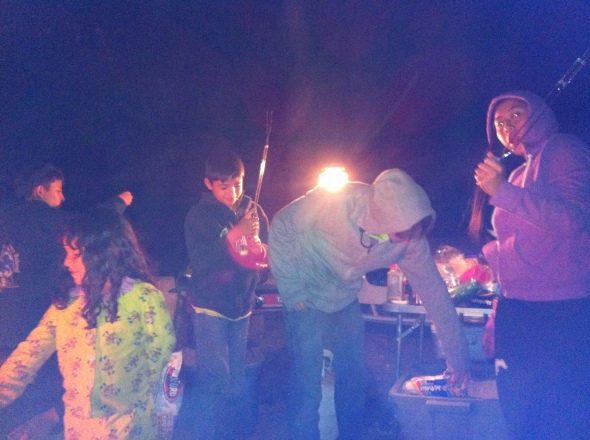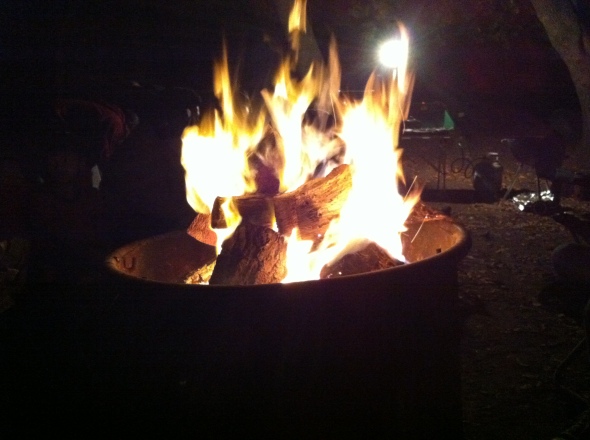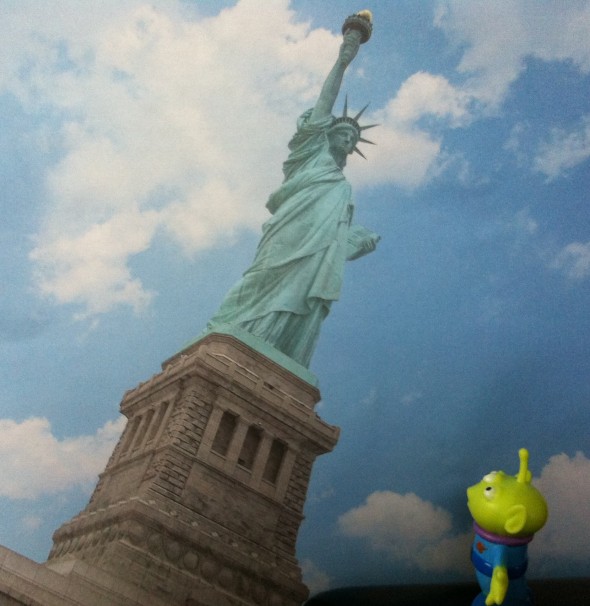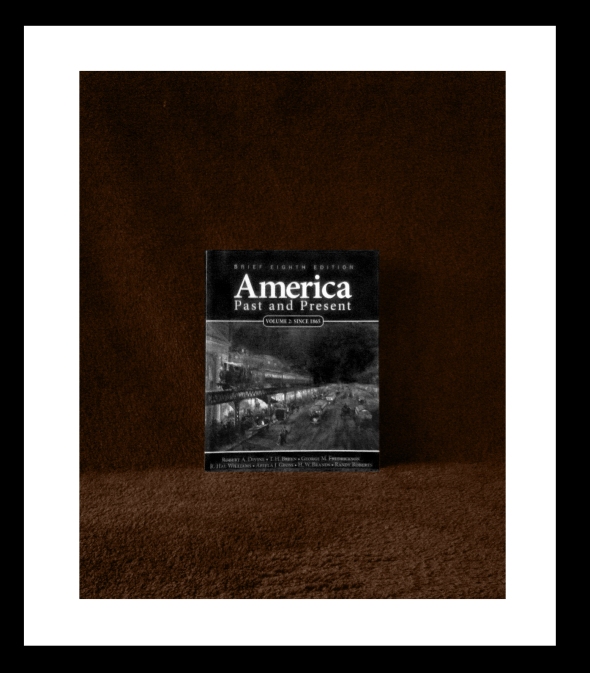Camping Calvert Style
Tradition has never really been a part of my family, so naturally we don’t have many. One of the few things that we would consider a family tradition is our annual camping trip. Every year for the last 10 years my brother and I pack up our families and go camping together in the summer. Both of our families look forward to the trip all year long. The last two years have been the most memorable because of a place called Pfeiffer Big Sur State Park. It’s a beautiful mind blowing experience into nature. The fresh air scented with redwood trees, the wild animals and the exhilarating short hike to the deeper, calmer parts of the river make this one of the most memorable experiences we, as a family, have ever had. The long road trip of 2-3 hours to get there is well worth it and filled with some amazing views. I learned about this place from a child hood friend. He and his wife have a family tradition of their own, going there year after year. Now we all share the tradition together celebrating a wonderful bonding experience with family and friends. I am so very grateful that they shared this place with me and I am more than happy to share my experience with you.
Here are some pictures from our last trip. Enjoy!
(Click on the images to enlarge)
Everyone always has a great time!
After a Long Day of Playing in the River
Would you like to plan a trip like this for your family?
This should help you get started.
- Booking for camp sites at Pfeiffer Big Sur is found at this link and, for the summer months, starts promtly at 8am on January 2nd. By 9am the whole park is usually fully booked for the entire summer so plan to get up early that day and pick your days and site before 8 so that you can check out as soon as they open. You can log in up to 10 minutes in advance to do this.
- Be sure to pack accordingly. Pfeiffer Big Sur is near the ocean and on a river. It can get fairly cold at night even in the summer so be sure to check forecasted temperatures. Sleeping bags are made for a variety of temperatures check yours to make sure they are capable of handling the weather while you’re there. Here’s a great camping supply list to help you plan your gear.
- Bring your own wood. You are not allowed to gather firewood from the forest. Wood is available for purchase on site but it is rather expensive and burns quickly. It’s best to bring your own if you can.
- Pack your food in solid containers. There are wild animals at Pfeiffer Big Sur. Foxes and Raccoons will try to get to your food at night if you don’t secure it. Squirrels and birds will boldly come in the day and snatch any unattended food as well. Coolers with heavy rocks on top is sufficient.
- Bring quarters for showers. If you plan to shower in the facilities available through out the park be sure to bring quarters. You’ll get about 5-7 minutes per quarter and the water is nice and warm.
- Bring toilet paper and hand soap. There are bathrooms available and while they are stocked with toilet paper they do run out. The bathrooms are not stocked with any kind of soap.
.
.
.
As you can tell by the map there are several places called “Big Sur” and a few called “Pfeiffer” in the area. There, however, is only one “Pfeiffer Big Sur State Park” so watch the signs carefully. Get directions from your house to Pfeiffer Big Sur State Park at this link.
.
.
.
.
.
If you can, take turns driving with someone else. The views on the way there, like the one in the picture below, are something not to be missed stuck behind the wheel. Having one person drive there and another drive back will allow both of you to fully enjoy the experience.
The Lodge
If you love nature and would just like the experience without actually camping, there is a lodge you can stay in on the grounds, but you’ll have to walk much farther to get to the good places by the river.
I hope you enjoyed this little tour of our family tradition.
Your Feedback is Welcome!
Please use the comment section below to leave feedback or to answer any of these questions:
- Have you ever been to Big Sur?
- Does your family ever go camping?
- Do you know of other amazing places to camp?
- Does your family have any other traditions that involve spending time out in nature?
Emulations
Emulations Project: Choose two images and create emulations.
Original: “Eiffel Tower” from “Tourism” series by Laurie Simmons, 1984
Laurie Simmons “Tourism” series ‘explores the ‘impossibility of the original experience'”[1]. This collection shows that no experience is ever truly unique. Anywhere you’ve ever gone, other people have been before you. The dolls she uses are intended to represent the average tourist showing that we’re really all just the same. Her work is intended to represent the idea of the memories of trips taken and not necessarily representational of actual trips the artist herself has experienced.
My Emulation:
My emulation, mostly due to my lack of dolls, is intended to extend that idea beyond the traditional idea of self to show that one day perhaps other beings may have these memories for themselves. Regardless of species the experiences are still not original experiences.
Original: “Some Theory” from “and 22 million very tired and very angry people” series by Carrie Mae Weems
Carrie Mae Weems is known for her work to represent a genuine stand against oppression The majority of her early work deals specifically with African-American culture and history. The collection this piece comes from, while still representative of African American struggles, cuts through racial boundaries and can be said to equally represent the struggles of class and inequality for all peoples. This particular piece “Some Theory” to me represents the illiteracy of the underprivileged and their inability to learn from books.
My Emulation:
My emulation is intended to stay within the spirit of the original, but rather than to point to illiteracy, it’s intended to evoke the thought “History is written by the victor”. The intention is to indicate that even if you may be able to read it, you may not really learn anything truthful.
.
Works Cited
[1] Mozo, Manuela. http://www.skarstedt.com/exhibitions/2000-11-08_laurie-simmons/#/images/2/
sammyslick. “Statue of Liberty”. http://sammyslick.deviantart.com/art/Statue-of-Liberty-217412135
New Digital Archive Museum. http://archive.newmuseum.org/index.php/Detail/Occurrence/Show/occurrence_id/202
The Coltan Crisis
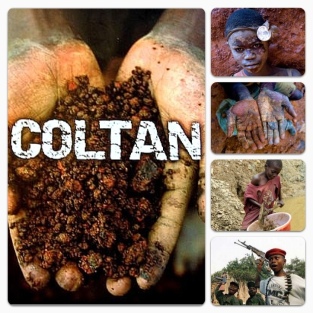
I walked into a Verizon wireless store recently and I found myself wanting to upgrade my current phone. I was approached by a customer service rep and as I am being greeted, I again think about the Samsung Galaxy SIII that I was just looking at and how it would be nice to have something newer and faster. Well, I ended up leaving the store still with my old trusty iPhone 3GS that has served me well ever since I got it. Later that night I started to reflect about my shopping experience and how countless other people go through that very same motion of desiring something shiny and new. I started to think about how many phones, and pretty much all electronics, become outdated, either because of technological advancements or fashion, and get replaced. I found that I was asking myself this one question: Where do all the resources come from to make all this? In my quest for information, I actually came across an important issue in regarding Coltan and mining in the Congo!
.
.
What is Coltan?
Coltan or columbite-tantalite is a metallic ore that that is highly essential in electronics today. Once refined coltan becomes a heat-resistant powder, called metallic tantalum, capable of holding a high electrical charge. Because of these properties coltan is used to create the tantalum capacitors used in pretty much all cell phones, tablets, laptops and other electronics.
.
.

Where does it come from?
Coltan was discovered around 1800. For years Coltan was mined all over the world, with the majority coming from either Australia or Brazil. In recent years, however, the Democratic Republic of the Congo has been the source of up to 80 percent of the Coltan produced. War rages in the Congo and the demand for Coltan, experts say, is one of the driving forces. Many of the mines are controlled by rebels and according to reports from the UN the Rwandan army as profited $250 million USD from the sale of Coltan in less than a year and a half. This is despite there not being any Coltan in Rwanda.
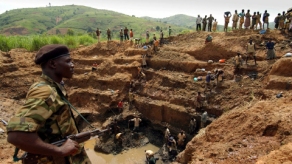
.
The Mining of Coltan
Coltan mining in the Congo utilizes very primitive methods. Generally teams of miners crape off surface mud and dig basins in streams. Sloshing the water around in the crater will then cause the Coltan ore to settle where it can then be retrieved from the bottom of the crater by miners. A good team can produce one kilogram, per day, of Coltan. One kilogram of Coltan is said to be valued at around $100.
The money made from the sale of Coltan is often spent on weapons to continue the conflict. In the last 10 years millions have died, families and even whole villages have been raided and massacred. While some of the mining is legitimate much of it uses slave-like labor and children are not immune to the struggle either. The use of child labor and children soldiers in the Congo is widely acknowledged.


.
.
.
.
.
.
.

Threatened Species
As if child labor, a slave like work force, rebel armies, constant conflict, and exploitation weren’t enough, Kahuzi Beiga National Park is located in the primary region where Coltan is mined. This area is home to the Mounatin Gorilla. Nearly half of the gorilla population in this area has been lost. Ground clearing in preparation for mining has reduced the gorillas’ available food supply. Unfortunatly this isn’t the only concern for the gorillas. The abject poverty of the displaced people in the area has lead to gorillas being hunted and sold for food to areas miners and rebel soldiers. It is feared that only about 3,000 gorillas now remain.
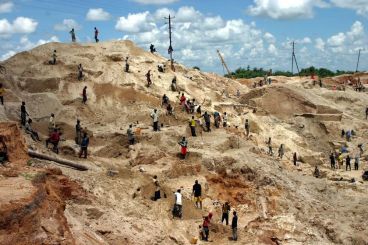
Soil Erosion and Land Degradation
The local people and animals aren’t the only ones being affected by this mining. In order to to mine for Coltan acres of forest have had to be cleared. The process of deforestation have had serious affects on the region’s environment. The rainforest’s capacity to absorb local greenhouse gasses emissions has been deminished. Soil erosion has become a serious problem which has lead to heavy silting of river water. Many species of rare plants have also been uprooted.
What is Coltan used for?
- Laptop computers
- Cellular phones
- Jet engines
- Rockets
- Cutting tools
- Camera lenses
- X-ray film
- Ink jet printers
- Hearing aids
- Pacemakers
- Airbag protection systems
- Ignition and motor control modules, GPS, ABS systems in automobiles
- Game consoles such as playstation, xbox and nintendo
- Video cameras
- Digital still cameras
- Sputtering targets
- Chemical process equipment
- Cathodic protection systems for steel structures such as bridges, water tanks
- Prosthetic devices for humans – hips, plates in the skull, also mesh to repair bone removed after damage by cancer
- Suture clips
- Corrosion resistant fasteners, screws, nuts, bolts
- High temperature furnace parts.
- High temperature alloys for air and land based turbines
Top 5 Things You Can Do To Limit Your Coltan Footprint:
- Use your electronics for as long as they serve your purpose. Do not upgrade purely for fashion.
- Buy refurbished and used products when ever possible
- Sell or give away goods you no longer need. Do not throw things away that could be used by someone else.
- Share and use sharing sites. Share infrequently used items with family and friends.
- Stop buying things you don’t need.
Videos:
More sites for relevant information:
Click to access china_and_congos_coltan_connection.pdf
Click to access coltansharparticle.pdf
http://www.child-soldier.org/child-soldiers-in-drc
Works Cited
http://www.worldheritagesite.org/sites/kahuzibiega.html
http://www.cbc.ca/news/technology/story/2010/12/10/coltan-faq.html
http://www.friendsofthecongo.org/resource-center/coltan.html
http://www.smh.com.au/articles/2009/05/08/1241289162634.html

